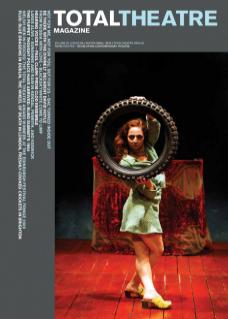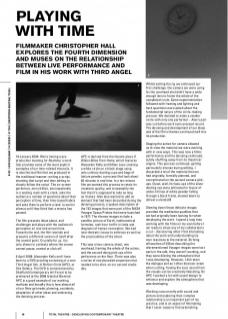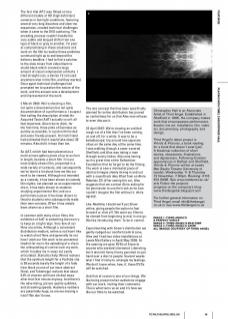18 January 2004: We’re having a preproduction meeting for Realtime, a work that provides some of the most explicit examples of our time-related interests. It is also the last film that we produced in the traditional manner: writing a script, shooting that script and then editing to closely follow the script. The on-screen performer, Jerry Killick, sits impatiently in a waiting room with a clock, asks the audience a number of questions about their perception of time, their time-based habits and asks them to perform a task: to wait in silence until they think that a minute has passed.
The film presents ideas about, and challenges and plays with the audience’s perception of, real and screen time. Towards the end, the film rewinds and presents a different version of itself after the rewind point. Crucially for us, it is only shown in contexts where the viewer cannot pause, rewind or click off.
6 April 2009: Alexander Kelly and I have been to a DVD proofing screening of a new Third Angel film, A Perfect Circle (APC), at Site Gallery. The DVD is commissioned by Sheffield Contemporary Art Forum to be premiered at the 2009 Istanbul Biennial. APC is a good example of our working methods and broadly this is how almost all of our films get made: planning, accidents, adaptation of other ideas and embracing the devising process.
APC is derived from the theatre piece 9 Billion Miles From Home, which features Alexander Kelly and Gillian Lees creating a white circle on a black stage using only culinary dusting cups and bags of talcum powder, a process that took about 40 minutes in real time. In a ten-minute film we wanted this process to retain its ritualistic quality, and to exemplify the fact that it’s supposed to take as long as it takes. Alex also wanted to add an element that had been discarded during the devising process, a spoken description of the 153 images that were part of the NASA Voyager Space Probes that were launched in 1977. The diverse images include a satellite picture of Earth, mathematical formulae, rush hour traffic in India and diagrams of human conception. We had new thematic issues to embrace as well as the practicalities of the shoot.
This was a two-camera shoot, one overhead, framing the whole of the action, and the second doing pick-ups of the performers on the floor. There was also a series of storyboarded sequences that needed to be shot, on our second studio day.
Whilst setting the rig we embraced our first challenge: the camera we were using for the overhead shot didn’t have a wide enough lens to frame the whole of the completed circle. Some experimentation followed with framing and lighting and hard questions were asked about the fundamental nature of the circle-making process. We decided to make a smaller circle with only one performer – Alex’s part was cut before we’d even pressed record. The devising and development of our ideas and of the film’s themes continued well into its production.
Staging the action for camera allowed us to view the material we were working with in new ways. This was now a filmic performance and the devising continued, subtly shuffling away from its theatrical origins. This process continued, getting particularly intense during editing. I discarded a lot of the material that we had originally, formally planned, and concentrated on the second camera pickups. Clean, well-lit close-ups of the silver dusting cup were jettisoned in favour of under-lit lines of white powder falling through a black frame, slowed down to almost a standstill.
Slowing down these delicate images provided the meditative qualities that we had originally been looking for when developing the work. I spend a long time working with the films on my own before I am ready to show any of my collaborators a cut – discovering what I find interesting about the work and understanding my own reactions to the material. Striking silhouettes of Gillian describing the aforementioned Voyager images were lost early in the edit, they weren’t working, and they were diluting the atmosphere that I was developing. However, I did retain the dialogue and as I often discover anew when cutting, freeing the sync sound from the visuals can be creatively liberating. On APC I worked a lot with sound design to enhance and explore the atmosphere that was developing.
Working concurrently with sound and picture and exploring their complex relationship is an important part of my practice, and is an aspect of filmmaking that I never cease to find astonishing.
The fact that APC was filmed on two different models of HD (high definition) cameras in low light conditions, featuring several very long dissolves and slow-mo sequences, created technical challenges when it came to the DVD authoring. The encoding process couldn’t handle the very subtle and languid shifts from one type of black or grey to another. I’m poor at compromising in these situations and work on the film to resolve these problems continued right up to and beyond the delivery deadline. I had to find a solution to the slow mixes from video black to studio black which created a large amount of visual compression artifacts. I tried straight cuts, a device I’d not used anywhere else in the film, and they worked. Once again technical challenges had prompted me to question the nature of the work, and the answer was a development and improvement of the work.
2 March 2003: We’re shooting a film, not quite a documentary but not quite documentation of a performance. I suspect that nailing the description of what An Acquired Taste (AAT) actually is isn’t all that important. Alex tries to drink, for the first time, three pints of Guinness as quickly as possible, in a pub with his dad and some friends present. An Irish friend had estimated that it would take about 30 minutes. Alex did it in less than ten.
So AAT, which had been planned as a multi-screen gallery piece of up to an hour in length, became a short film. It is our most widely shown film, presented in a wide variety of contexts, and consequently we’ve learnt a lot about how we like our work to be viewed. Although not intended as a comedy, it has been shown at comedy film nights; not planned as an experimental short, it has been shown to students studying experimental film; and as a performance piece it has been shown to theatre students who subsequently made their own versions. Often it has simply been shown as a short film.
In common with many of our films, the exhibition of AAT is something that we try to keep on a tight reign. Very few of our films are online. Although a convenient distribution medium, online is not how I like to watch short films and generally its not how I wish our film work to be presented. Implicit for me in the uploading of a clip is the relinquishing of control over my work, which troubles me in ways not easily articulated. Statistics help: Wired reckons that the optimum length for a YouTube clip is 59 seconds (easily the length of a fade from black on one of our more abstract films), and Tubemogul reckons that about 54% of viewers will have clicked away after that first minute anyway. And there’s the advertising, picture quality quibbles, and streaming speeds. Audience numbers are potentially huge, so are we missing a trick? We don’t know.
The one concept that has been specifically planned for online distribution has proved so contentious for us that Alex now refuses to even discuss it.
23 April 2007: We’re viewing an untitled rough cut of a film that I’ve been cutting, on and off, for a while. It was to be a kaleidoscopic trip around two separate cities on the same day at the same time. I was walking through a snow-covered Sheffield, and Alex was taking a tram through sunny Lisbon. Alex was having such a great time at the Gulbenkian Foundation that he forgot to do the filming. The work is now a minimalist piece of abstract images slowly mixing in and out with a soundtrack idea lifted from an Akira Rabelais CD. After seeing the cut, Alex suggests that we contact Akira asking for his permission to use the track as he now couldn’t imagine the film without it. Akira agreed.
Like Realtime, I doubt we’ll put Snow online, giving people the option to fast forward or click off. We want our films to be viewed from beginning to end, in one go. We like introducing them. To be in control.
Experimenting with Snow’s distribution we gently nudged our comfort/control zone. Alex and I had two video installations at Leeds Met Gallery in April/May 2009. At the opening we gave DVDs of Snow to anyone who seemed interested. Liberating, but it also felt funny (funny peculiar) to just hand over a disc to people. Several weeks later I find it tricky to untangle my feelings. We don’t know when, how, if, those DVDs will be watched.
And that of course is one of our things. We like being present when audiences engage with our work, inviting their comments. This is what turns us on and it’s how we like our films to be watched.
Christopher Hall is an Associate Artist of Third Angel. Established in Sheffield in 1995, the company makes work that encompasses performance, theatre, live art, installation, film, video art, documentary, photography and design.
Third Angel’s latest project is Words & Pictures, a book reading for a book that doesn’t exist (yet). A theatrical collection of short stories, obsessions, illustrations and digressions. Following October appearances in Belfast and Sheffield, Words & Pictures will be at Leeds Met Studio Theatre (University of Leeds), Wednesday 11 & Thursday 12 November, 7.30pm. Booking: 0113 812 5998. See www.leedsmet.ac.uk/ arts Follow the projects progress on the company’s blog: www.thirdangeluk.blogspot.com
For further general information on Third Angel, email info@thirdangel. co.uk or see www.thirdangel.co.uk


